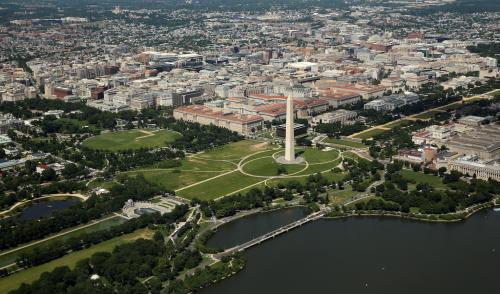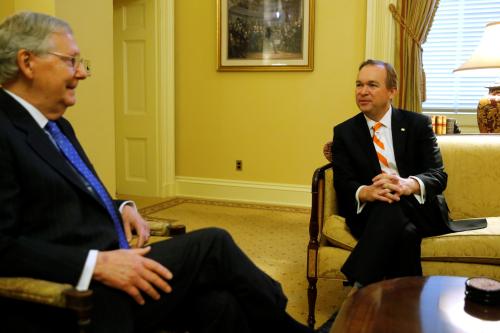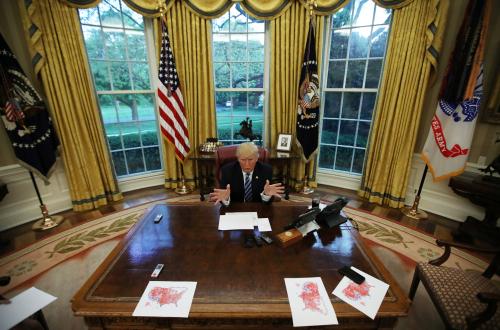This post is part of a series on the need for government reform and how to get it done. For more on this topic, visit the series page.
The final threat to bureaucratic performance is the decline in the capacity to design, enact, and implement major government reform. The number of major reforms has dropped over the last half-century, as has the number of large-scale reforms. It is no longer clear that Congress and the president could enact a package of large-scale reforms even if they wanted to. Tinkering—either government-wide small-scale reforms or reforms targeted to specific agencies or administrative procedures—may be the best they can do.
Government management may have faded in recent decades, but it produced three distinct periods of reform on my list of the 210 most significant reforms enacted since 1945: (1) a wave of post-World War II reforms that included civil service reform, reorganization authority, administrative procedures, freedom of information, and the creation of new agencies such as the Peace Corps, NASA, Transportation, and Housing and Urban Development, (2) a surge of post-Watergate reforms that centered on open government, the inspectors general, ethics in government, paperwork reduction, and a long list of war-on-waste laws, and (3) during the 1990s with Vice President Gore’s reinventing government campaign, focused on government performance measurement, procurement streamlining, presidential transitions reform, and further expansion of sunshine-in-government laws.[1]
Figure 1
Figure 1 shows a sharp decline in the number of large-scale reforms such as civil service reform, whistleblower protections, accounting rules, and reorganization that address government-wide issues. Whether with their support or under congressional pressure, the Truman, Reagan, and Clinton administrations emerged as the great engines of reform, while the Trump administration focused on breaking programs rather than fixing agencies.
President Obama was ready to take a more aggressive path only three years into his presidency when he joked about salmon regulation in his 2011 State of the Union Address and promised action to simplify the federal organizational chart.[2] He returned to the need for reform the next year when he asked Congress for up-or-down authority to reorganize federal agencies and even promised to create a “Secretary of Business” in May 2013 as a “one-stop-shop” for economic renewal. Although Republicans not-so-politely rejected the proposal, Obama did produce a shortlist of presidential appointment and transition reforms, a number of anti-waste and open-government reforms, and the 2014 Veterans Access to Care Through Choice Act that President Trump has repeatedly claimed as his own. Obama’s plan would not have reduced the true size of government but would have brought reorganization back into vogue as a reform tool.
Government reform comes in more than big and small packages. It also comes in the form of new philosophies such as Gore’s embrace of liberation management. Although reinventing government contained its share of familiar civil service reforms associated with downsizing and reclassification, Gore was also committed to the freedoms promised in the Government Performance and Results Act: alternative dispute resolution, regulatory reform, and increased transparency across a streamlined bureaucracy. Many of these reforms went to seed a decade later during the Iraq war, but the precedents were set for the future.
Just because reform proposals are based on established law and traditional theories does not doom them to failure, but a blend of new and old, big and small might be well-advised in a period of great bureaucratic stress and significant political pressure. Despite the public’s current demand for major reform, Figure 2 shows a significant decline in activity and a drift toward smaller and older reforms.[3] The number of reforms built on old ideas exceeded the new under Carter (10 to 8), Reagan (17 to 14), H.W. Bush (6 to 5), George W. Bush (8 to 3), Obama (11 to 4), and Trump (6 to 2). President Clinton was the only president with a net plus on new ideas (21 new ideas to 16 old ones), in no small part because of Gore. This is not to argue that new ideas have always led reform—the Clinton administration was the first administration since the end of World War I to generate more ideas than old.
Nevertheless, Figure 2 should raise questions about both the inventory of government management reform and the level of innovation in reserve.
Figure 2
The pace of reform depends in part on the politics of the moment, party pressure, and the institutional capacity to innovate. Much of the bureaucratic construction that followed World War II involved the repair, revision, and expansion of the New Deal’s alphabet agencies. Some of that work had begun before the war with the Brownlow Commission and the 1939 Reorganization Act, but the bulk of the legislative activity was driven by the post-war reorganizations and push for regulatory discipline. More recently, process reforms that enable greater transparency and consistency, such as freedom of information and civil service reform protection, have been in vogue, while structural reforms have dropped significantly as disappointments with past mergers such as the Department of Veterans Affairs and Homeland Security have reduced interest in grand reorganizations.
Democratic presidents were more often the source of these and other scientific management reforms, while Republican presidents have been content to wage wars on waste. In turn, the presidency was more often the source of scientific management reforms, while the Congress was by far the most active source of “sunshine-in-government” statutes. But the public now more than ever is begging that government, of which it lacks trust and is skeptical, to be reformed significantly and thoroughly. Notwithstanding Trump’s record as a dismantler, presidents remain the institution builders, and, if elected, Mr. Biden has a chance to remake the presidency as a source of good government. The question is whether he will have anything to say.
[1] This analysis is based on my review of major congressional reform statutes enacted between 1945 and 2020, which is based in turn on my reading of the Congressional Quarterly’s summaries of major legislation in each Congress. Most of my coding is based on my review of major legislation in the annual CQ Almanac. My decision to include or exclude a statute as a major reform is based on my own experience in the field and, therefore, should be taken as my reading only. I did not ask whether a specific statute was successful or even faithfully implemented, but whether it was a significant addition to the government improvement, and measured its size (large/small) by the range of its effect across government as a whole, the newness of the idea by its fit with contemporary bureaucratic practice, its implementation approach (centralized or decentralized) by a plain reading of the statute, and its view of government (trusting or distrusting) by a plain reading, too. For an introduction to my approach, see Paul C. Light, The Tides of Reform: Making Government Work, 1945-1995, New Haven, CT: Yale University Press, 1997.
[2] Obama noted that salmon were regulated by not one, but two federal agencies: “The Interior Department is in charge of salmon while they’re in fresh water, but the Commerce Department handles them when they’re in saltwater,” Obama said. “I hear it gets even more complicated once they’re smoked.” See Barack Obama, “Address Before a Joint Session of the Congess on the State of the Union,” January 25, 2011, available at the American Presidency Project, University of California Santa Barbara,
[3] Old reforms are identified in my coding system by links to core statutes from earlier reform periods such as the Administrative Procedures Act, Civil Service Act, and so forth, while new statutes are defined as breaks with the same core statutes. In turn, size is defined by a statute’s scope of coverage across the federal government. The coding here is highly subjective, but is designed to separate reforms that augment existing practices from reforms that break with the prevailing wisdom based on my reading of federal administrative practice.







Commentary
Washington has given up on big-ticket reform
October 12, 2020